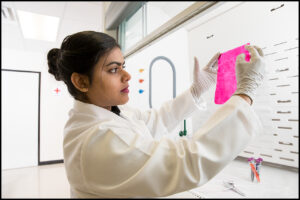
Did you know that the shirt you’re wearing right now took three years of drinking water (roughly 2,700 liters) to make?
Current textile dyeing and washing processes consume massive quantities of water and release large amounts of dye into the environment. Conventional dyeing methods also involve a dye bath that contains dissolved forms of reactive dye and dye auxiliaries.
However, this method does not ensure stable fixation of the dye, with approximately 20 to 30 percent rinsing off during the washing process. Unsurprisingly, this results in large amounts of contaminated water.
Anuradhi Liyanapathiranage, a doctoral student in the Department of Textiles, Merchandising, and Interiors, is working to change that by developing a novel, eco-friendly textile dyeing method.
Liyanapathiranage’s research focuses on developing a sustainable textile dyeing technique; using a natural polysaccharide called Fibrillated Nanocellulose (NFC) as an efficient carrier of textile dyes.
Project advisors Dr. Sergiy Minko and Dr. Suraj Sharma and their respective laboratory staff have spent the past five years working with NFC.
NFC is non-toxic and engineered from abundantly available cellulose sources, making it a green alternative to the current environmentally hazardous textile dyeing industry standards and practices.
Liyanapathiranage’s research uses dye molecules which are covalently attached to the nanocellulose. This allows the nanocellulose to efficiently carry the dye to the fabric surface.
“In simple terms, we dye the nanocellulose instead of dyeing the fabrics,” Liyanapathiranage explains. “We then deposit the dyed nanocellulose on the fabrics rather than using a conventional dye bath.”
“As the dye fixed to nanocellulose exists in the nano-scale, it achieves a faster rate of diffusion across the fabric. Furthermore, the nanocellulose ensures the permanent retention of dye molecules by forming stable physical bonds.”
This new technology delivers excellent dye performance compared to the conventional dyeing method.
With their new technology, the team has been able to reduce the water requirement to dye one kilogram of cotton from 19 liters to just 1.9 liters.
The project team’s recent studies on chemical crosslinking post-treatments for NFC dyeing technique assures a 60 percent reduction of dye discharge during the washing process. Furthermore, life cycle analysis of their new dyeing technique shows this process utilizes less energy and has a lower carbon footprint compared to the conventional dyeing method.
These key benefits make the technology more applicable to the industry.
In 2016, the team successfully concluded the first phase of their research, which was also published and patented.
Ongoing research on the project includes various chemical finishes to improve dye performance and textile texture. The team is also working on ways to upscale the technology into a reliable production process.
Liyanapathiranage stresses that she believes in social transformation through science. After graduation, she plans to seek out and engage in opportunities that fulfill her passion as a research scientist.
“As an emerging scientist, I look forward to cultivating the socio-economic impact of my research. As an individual who has worked in the industry, I also firmly believe there must be an active partnership between academia and industry to address current challenges in an innovative way.”
“My current research on nanocellulose-based sustainable textile dyeing fits perfectly with my vision of doing an impactful Ph.D. program. The growth market for renewable materials and sustainable technologies is very promising. I am confident our research will be widely applied in the industry.”
